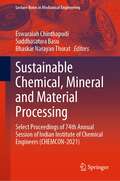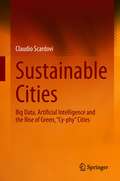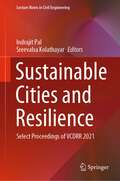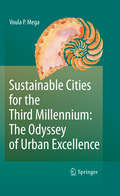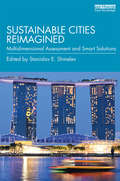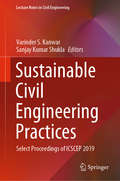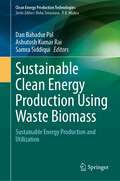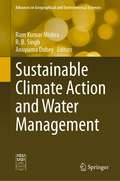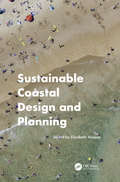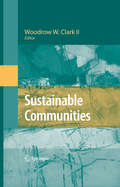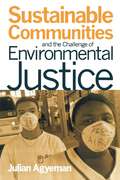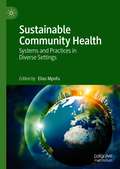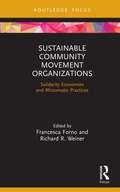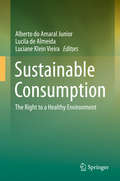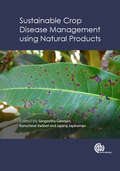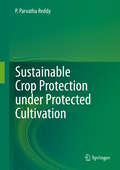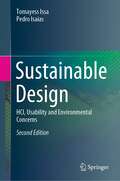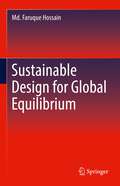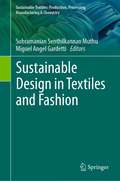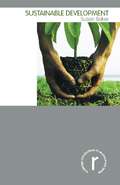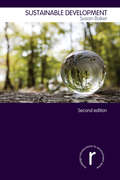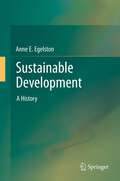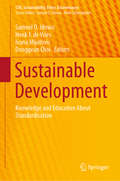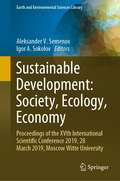- Table View
- List View
Sustainable Chemical, Mineral and Material Processing: Select proceedings of 74th Annual Session of Indian Institute of Chemical Engineers (CHEMCON-2021) (Lecture Notes in Mechanical Engineering)
by Eswaraiah Chinthapudi Suddhasatwa Basu Bhaskar Narayan ThoratThis book presents select proceedings of the Indian Chemical Engineering Congress (CHEMCON-2021) under the theme "Sustainable Utilization of Resources for Chemical Mineral Sectors". It covers broad topics such as chemical reaction and processes, material science and engineering, coal and mineral processing, pyro- and hydro-metallurgical processes, environmental engineering and waste management, advanced engineering, and energy materials. This book is useful for the researchers, professionals, and policymakers interested in sustainable utilization of chemical and mineral resources.
Sustainable Cities: Big Data, Artificial Intelligence and the Rise of Green, “Cy-phy” Cities
by Claudio ScardoviGlobal cities are facing an almost unprecedented challenge of change. As they re-emerge from the Covid 19 pandemic and get ready to face climate change and other, potentially existential threats, they need to look for new ways to support wealth and wellbeing creation – leveraging Big Data and AI and suing them into their physical reality and to become greener, more inclusive and resilient, hence sustainable.This book describes how new digital technologies could be used to design digital and physical twins of cities that are able to feed into each other to optimize their working and ability to create new wealth and wellbeing. The book also describes how to increase cities’ social and economic resilience during crisis time and addressing their almost fatal weaknesses – as it became all too obvious during the recent COVID 19 crisis. Also, the book presents a framework for a critical discussion of the concept of “smart-city”, suggesting its development into a “cyber” and “meta” one – meaning, not only digital systems can allow physical ones (e.g. cities, citizens, households and companies) to become “smarter”, but also the vice versa is true, as off line data and real life behaviours can support the optimization and development of virtual brains as a sum of big data and artificial intelligence apps all sitting “over the cloud”. An analysis of the fundamental dynamics of this emerging “info-telligence” economy, and of the potential role of big digital players like Amazon, Google and Facebook is then paving the way to discuss a few strategic forays on how traditional sectors such as financial services, real estate, TMT or health could also evolve, leveraging Big Data and AI in a cyber-physical integrated setting. Finally, a number of thought provoking use cases that could be designed around individuals, and to improve the success and the resilience of households and companies living and working in urban areas are discussed, as an example of one of the most exciting future markets to come: the one of global, sustainable cities
Sustainable Cities and Resilience: Select Proceedings of VCDRR 2021 (Lecture Notes in Civil Engineering #183)
by Indrajit Pal Sreevalsa KolathayarThis book presents the select proceedings of the Virtual Conference on Disaster Risk Reduction (VCDRR 2021). It provides insights on urban resilience and sustainable infrastructure. All the chapters in this volume are segregated into five clusters, e.g., Resilient infrastructure in construction, Innovative construction interventions, Waste Management and Disaster Risk Reduction, Urban Development and Sustainability, and Cross-cutting issues. Various topics covered in this book are risk assessment, prevention, mitigation, preparedness and response, renewable energy, waste management, resilient cities, and environmental management. This book is a comprehensive volume on disaster risk reduction (DRR) and its management for a sustainable built environment. This book will be useful for the students, researchers, policy makers and professionals working in the area of civil engineering, especially disaster management.
Sustainable Cities for the Third Millennium: The Odyssey of Urban Excellence
by Voula P. MegaThis book offers a 360 degree view of the challenges facing cities at the dawn of the millennium in terms of growth, governance, institutions and infrastructures, environmental well-being, social integration, science, culture and the arts, urban renaissance and planning, local democracy and citizenship. One year afte the crisis that started in 2008, the book presents responses to overcome the crisis of values and engage in a sustainability path from European and world cities.
Sustainable Cities Reimagined: Multidimensional Assessment and Smart Solutions
by Stanislav ShmelevTo assess urban sustainability performance, this book explores several clusters of cities, including megacities, cities of the Global South, European and North American cities, cities of the Middle East and North Africa, cities of Central and South East Asia, a city state of Singapore and a large group of global cities. It applies a multi-criteria approach using a panel of environmental, economic, social and smart indicators to assess progress and policies in global cities including London, New York, Hong Kong, San Francisco, Los Angeles, São Paolo, Rio de Janeiro, Buenos Aires, Paris, Berlin, Stockholm, Moscow, Beijing, Seoul, Singapore, Shanghai, Sydney, Tokyo and many others. Additional attention is given to the issues of climate change, poverty and smart dimensions, with renewable energy and the drivers of urban CO2 emissions playing the central role. This book is abundant with case studies considering strategies, policies and performance of the leading cities, including San Francisco, Stockholm and Seoul in greater depth, exploring how their successes can be used by other cities. The book identifies key linkages between different smart and sustainability dimensions as well as investment opportunities in cities with sustainability potential. This book will be of great interest to policy makers, city and regional authorities as well as scholars and students of urban planning and sustainable development aiming to facilitate a sustainability transition in our cities around the world.
Sustainable Civil Engineering Practices: Select Proceedings of ICSCEP 2019 (Lecture Notes in Civil Engineering #72)
by Varinder S. Kanwar Sanjay Kumar ShuklaThis book comprises select proceedings of the International Conference on Sustainable Civil Engineering Practices (ICSCEP 2019). It covers several important aspects of sustainable civil engineering practices dealing with effective waste and material management, natural resources, industrial products, energy, food, transportation and shelter, while conserving and protecting the environmental quality and the natural resource base essential for future development. The book also discusses engineering solutions to sustainable development and green design issues. Special emphasis is given on qualitative guidelines for generation, treatment, handling, transport, disposal and recycling of wastes. The book is intended as a practice-oriented reference guide for researchers and practitioners, and will be useful for all working in sustainable civil engineering related fields.
Sustainable Clean Energy Production Using Waste Biomass: Sustainable Energy Production and Utilization (Clean Energy Production Technologies)
by Dan Bahadur Pal Ashutosh Kumar Rai Samra SiddiquiThis edited volume covers sustainable biomass valorization and its application in various sectors.Bioenergy has concerned enormous attention as a promising alternative to conventional energy resources. Abundance of bioresources and their renewable nature provides a distinct advantage to biofuels from sustainability perspective. Biofuels have found increasing applications in the energy and transportation sector in recent years. Blended fuels are being used worldwide. However, several challenges remain to be addressed due to the diverse nature of biomasses and inherent recalcitrant nature of biological materials used as feedstock. This book aims to provide an overview of recent developments in the production of bioenergy and its applications in various areas. Specific emphasis is given to production of biofuels from modern biomass such as agro-forest waste and dedicated non-edible energy crops that do not interfere with food production. The scope of the book covers synthesis and characterization of biologically derived fuels, advances in microbiological methods and enzyme engineering approaches. The book covers techno-economic analysis to identify challenges and prospects for commercialization of biofuels. The directions for future research should pave way for net zero scenario for a sustainable world.The book will cater to a wide range of readers interested in learning the fundamentals as well as advances in the field of biofuels.
Sustainable Climate Action and Water Management (Advances in Geographical and Environmental Sciences)
by Ram Kumar Mishra R. B. Singh Anupama DubeyThis book discusses various issues relating to water resources, climate change and sustainable development. Water is the main driving force behind three major pillars of sustainable development: environmental, social and economic. As stated in the United Nations Sustainable Development Goals, development of these pillars rests on the availability and management of resources to fulfill the demand for water. By identifying the various challenges in the context of water resources and climate change, the book offers insights into achieving a better and more sustainable future. It provides a unique forum for practitioners and academics to exchange ideas on emerging issues, approaches, and practices in the area of water resources, climate change, and sustainability, while also presenting valuable information for policymakers on the changing contours of water management and climate change mitigation. As such it is a useful resource for decision-makers at the local as well as the global level.
Sustainable Coastal Design and Planning
by Elizabeth MossopAs different parts of the globe deal with the challenges of coastal settlements in the Anthropcene landscape of increasing uncertainty, the methods of design offer new strategies for developing and testing solutions. These complex problems require collaboration across disciplines, with scientists, planners, engineers, designers, and others able to work together in finding new ways of living in coastal and changing landscapes. Sustainable Coastal Design and Planning is an outstanding collection of essays by leading practitioners and academics from across the globe on design and planning for coastal resilience in the face of climate change. It thoroughly explores the questions of coastal change at different scales and provides international case studies that illustrate diverse strategies in different geographies and cultures. Taken as a whole, they canvas a broad palette of approaches and techniques for engaging these complex problems. Divided in two parts, this book focuses on how to develop solutions through multidisciplinary design thinking and informs all stakeholders on specific methods and practices that will be needed to work effectively in this dynamic space.
Sustainable Communities
by Woodrow W. Clark IIThe book starts with a discussion of global warming and climate change. The problem is well documented. Part One gives background for sustainable developments and gives studies of proven, substantiated and documented solutions. The time to act has begun. The "Green Revolution" has begun. Some authors call it The Third Industrial Revolution (Rifkin, 2005) since in the 21st century the industrially developed world has begun to move rapidly from fossil fuels (The Second Industrial Revolution) to renewable energy generation, storage technologies, and sustainable communities. Now is the time to understand and learn the tools that make sustainable communities of all kinds real. The book provides a vast, but not the total, amount of materials and data. The intent is to give students of sustainable development some well-established resources and tools. By 2008, the concept of "Green" had been so much in marketing and product services that it lost its meaning. The "branding" of green meant a whole new industrial sector suddenly emerged globally. However, the proof that there is both a Green Revolution and actual solutions to global warming must be seen in those sustainable communities who have existed, grown or developed using tested tools for sustainability. One of the key tools is the concern for conservation of natural resources, energy efficiency and the use of renewable energy systems (solar, wind, geothermal and bio-mass among others) along with storage devices for power generation. Communities in Europe and Asia have lead the way historically. The book presents actual cases of sustainable communities. The case of Frederikshavn in Denmark (Chapter # 6) clearly illustrates how small towns and villages can be sustainable. Far more intuitive and with common sense, Dos Lagos in California (Chapter #4) demonstrates how concern for the natural environment can create a mix-use community of homes, shops, offices and a golf course. Far more planned and strategic are the nine college campuses of the Los Angeles Community College District (Chapter #3) who recognized that public policy and that sector must lead the private sector by example as well as by proving the tools and economics of sustainable communities. And the private sector took note. A number of private companies from Safeway with its 20+ energy independent storage facilities to Toyota with Platinum LEED (Leadership in Environment and Energy Design) USA Headquarters in Torrance, California. Honda was not far behind with its "Green Hydrogen" Refueling station that electronizes solar energy into hydrogen for its hydrogen fuel cell cars. The Green Revolution could be seen with the hybrid cars that lead Toyota to be the No #1 Auto maker. Part Two of the book reviews the tools needed to make sustainable communities anywhere in the world. The key one is the technology (s) from science and engineering (Chapter #8). All too often people do not know that there are environmentally sound technologies that exist today (Clark, 2000) to make communities sustainable. Then when the political leaders discover that the technologies exist they argue that the costs are too high. Not true. And certainly not true today as Chapter #9 clearly demonstrates. There is the need to rethink basic cost benefit analyses for goods and services as being in the short term (2-3 years) into life cycle analyses (1-20 years) along with triple bottom line benefits and externality economic impacts on health, pollution and the atmosphere. In the end sustainable communities must be just that: capable of producing and using their own resources. Global warming starts and can end locally. If they need resources from outside or a long distance away, then those needs must be environmentally sound in terms of the goods themselves. And especially they must be sustainable in terms of transportation and services. This local and global change means new paradigms and approaches in public policy, environmentally sound technologies, economics and systems must be implemented today. Such a sustainable ...
Sustainable Communities and the Challenge of Environmental Justice
by Julian AgyemanPopularized in the movies Erin Brockovich and A Civil Action, "environmental justice" refers to any local response to a threat against community health. In this book, Julian Agyeman argues that environmental justice and the sustainable communities movement are compatible in practical ways. Yet sustainability, which focuses on meeting our needs today while not compromising the ability of our successors to meet their needs, has not always partnered with the challenges of environmental justice.Sustainable Communities and the Challenge of Environmental Justice explores the ideological differences between these two groups and shows how they can work together. Agyeman provides concrete examples of potential model organizations that employ the types of strategies he advocates. This book is vital to the efforts of community organizers, policymakers, and everyone interested in a better environment and community health.
Sustainable Community Health: Systems and Practices in Diverse Settings
by Elias MpofuApplying a trans-disciplinary approach, this book provides a comprehensive, research-based guide to understanding, implementing, and strengthening sustainable community health in diverse international settings. By examining the interdependence of environmental, economic, public health, community wellbeing and development factors, the authors address the systemic factors impacting health disparities, inequality and social justice issues. The book analyzes strategies based on a partnership view of health, in which communities determine their health and wellness working alongside local, state and federal health agencies. Crucially, it demonstrates that communities are themselves health systems and their wellbeing capabilities affect the health of individuals and the collective alike. It identifies health indicators and tools that communities and policy makers can utilize to sustain truly inclusive health systems. This book offers a unique resource for researchers and practitioners working across psychology, mental health, rehabilitation, public health, epidemiology, social policy, healthcare and allied health.
Sustainable Community Movement Organizations: Solidarity Economies and Rhizomatic Practices (Routledge Focus on Environment and Sustainability)
by Francesca Forno Richard R. WeinerThis volume shines a light on Sustainable Community Movement Organizations (SCMOs), an emergent wave of non-hierarchical, community-based socio-economic movements, with alternative forms of consumption and production very much at their core. Extending beyond traditional ideas of cooperatives and mutualities, the essays in this collection explore new geographies of solidarity practices ranging from forms of horizontal democracy to interurban and transnational networks. The authors uniquely frame these movements within the Deleuzian concept of the ‘rhizome’, as a meshwork of alternative spaces, paths and trajectories. This connectivity is illustrated in case studies from around the world, ranging from protest movements in response to austerity measures in Southern Europe, to the Buen Vivir movement in the Andes, and Rotating Savings and Credit Associations (ROSCAs) in the Caribbean and Canada. Positioning these cases in relation to current theoretical debates on Social Solidarity Economy, the authors specifically address the question of the persistence and the durability of the organizing practices in community economies. This book will be a valuable tool for academics and students of sustainable consumption, environmental policy, social policy, environmental economics, environmental management and sustainability studies more broadly.
Sustainable Consumption: The Right to a Healthy Environment
by Lucila De Almeida Alberto do Amaral Junior Luciane Klein VieiraThis book provides a broad understanding of whether law plays a role in influencing patterns of sustainable consumption and, if so, how. Bringing together legal scholars from the Global South and the Global North, it examines these questions in the context of national, transnational and international law, within single and plural legal systems, and across a range of sector-specific issue areas.The chapters identify how traditional legal disciplines (e.g. constitutional law, consumer law, public procurement, international public law), sector-related regulation (e.g. energy, water, waste), and legal rules in specific areas (e.g. eco-labelling and packing) engage with the concept of sustainable consumption. A number of the contributions describe this relationship by isolating a national legal system, while others approach it from the vantage point of legal pluralism, exploring the conflicts and convergences of rules between multiple international treaties (or guidelines) and those between the rules of international and transnational law (or both) vis-à-vis national legal systems. While sustainable consumption is recognised as an important field of interdisciplinary research linking virtually all social science disciplines, legal scholarship, in contrast, has neglected the importance of the field of sustainable consumption to the law. This book fills the gap.
Sustainable Crop Disease Management using Natural Products
by Sangeetha Ganesan Kurucheve Vadivel Jayaraj JayaramanAlternative methods of disease control such as natural products and compounds derived from biological origins, provide an effective alternate to the use of chemical products or a means to minimize their use. It is imperative now to look for such sustainable crop disease management approaches, that include routine and alternative methods. Natural products for sustainable crop disease management is an effort in this direction, and deals with immediate concerns in the field of natural and alternative products for disease control, apart from using biocontrol organisms. This book presents up-to-date information on natural products and compounds derived from biological origins and thoroughly discusses their applicability, field use and prospects for adoption under different cropping conditions. This book also validates disease management strategies.
Sustainable Crop Disease Management using Natural Products
by Kurucheve Vadivel Sangeetha Ganesan Jayaraj JayaramanAlternative methods of disease control such as natural products and compounds derived from biological origins, provide an effective alternate to the use of chemical products or a means to minimize their use. It is imperative now to look for such sustainable crop disease management approaches, that include routine and alternative methods. Natural products for sustainable crop disease management is an effort in this direction, and deals with immediate concerns in the field of natural and alternative products for disease control, apart from using biocontrol organisms. This book presents up-to-date information on natural products and compounds derived from biological origins and thoroughly discusses their applicability, field use and prospects for adoption under different cropping conditions. This book also validates disease management strategies.
Sustainable Crop Protection under Protected Cultivation
by P. Parvatha ReddyThis book focuses on pests (insect and mite) and diseases (fungal, bacterial, viral and nematode) in protected horticulture (fruits, vegetables and ornamentals) using physical, cultural, chemical, biological, host resistance, and integrated methods. It opens with chapters describing the setting in which integrated pest and disease control operates, i. e. , the greenhouse and its environment. Subsequent chapters present the basic strategies and tactics of different control methods including integrated control, with special reference to greenhouse crops. Further chapters include the different facets of biological pest and disease control - its scientific bases, its development in practice, its commercialization and quality control. The concluding chapters of the book highlight the present status of integrated pest and disease control for the most important greenhouse crops (fruits, vegetables and flower crops) worldwide. The book's final chapter explores future challenges for researchers assigned to identify non-pesticide methods and integrate sustainable pest management technologies that can contribute to increased productivity, such as breeding for durable resistance, biological control and devising integrated methods that will have minimal adverse environmental and social impacts. Among productivity-enhancing technologies, protected cultivation has a tremendous potential to increase the yield of vegetables and flower cro ps by several fold. Pests and diseases are one of the major challenges to protected cultivation. Year-round warm temperatures and relatively high humidity together with abundant food make the protected environment of greenhouses highly attractive to pests and diseases. Nevertheless, very little attention has been paid to the manipulation of greenhouse environments expressly to avoid disease epidemics and insect infestations, which together can easily account for 30% of crop losses. This book will be of immense value to all members of the scientific community involved in teaching, research and extension activities on protected horticulture. It also offers a useful reference guide for policymakers and practicing farmers, and can be used as a textbook for postgraduate courses.
Sustainable Design: HCI, Usability and Environmental Concerns
by Pedro Isaias Tomayess IssaThis book is concerned with the importance of Human Computer Interaction (HCI), Usability, user participants, and Sustainability in the Information Communication Technology (ICT) industry throughout the world. ICTs have become a crucial instrument for communication, entertainment, commerce and research and this increased usage is presenting new environmental and sustainability issues as we try and meet the ever-growing needs of both businesses and individuals. Sustainability and sustainable design must become central to the design of new technologies to make a concerted effort to tackle the environmental concerns we face now and in the future. Development frameworks, tools and models are used and explored, and the New Participative Methodology for Sustainable Design (NPMSD) is introduced as a way of identifying key factors needed in developing more sustainable systems including new smart technology and portable devices.In this book, the sustainable step in the design stage is evaluated and assessed by 11 countries: namely, Australia, Brazil, China, Germany, India, Norway, Singapore, South Korea, Sweden, UK, and USA. The new results are generated confirming that sustainable design awareness should be considered by designers, and users to minimize and reduce the carbon emissions, raw materials usage, and global warming, since these problems should be tackled soon, otherwise, it will be too late to solve it. Further research is needed in the future to implement and assess the sustainable design step with large IT companies to ensure compliance with environmental standards and rules for sustainable systems.Sustainable Design is an invaluable resource for students and researchers, designers and business managers who are interested in the human-centered, environmental concerns of sustainable technologies.
Sustainable Design for Global Equilibrium
by Md. Faruque HossainThis book focuses on holistic approaches of applying sustainable practices in all sectors of building, infrastructure, and energy to achieve a best-balanced global energy, building, infrastructure, transportation, and water technology (EBITW) regime. It presents a series of solutions based on innovative research and applications for building a sustainable Earth for future generations. The goal of this book is to define the context of instigation for thinking through the scientific theories and practical applications of sustainability mechanisms to confirm a global equilibrium by the implementation of the following main practices: Sustainable Energy, Sustainable Architectural and Engineering Design Technology, Sustainable Environment and Society, and Sustainable Earth.
Sustainable Design in Textiles and Fashion (Sustainable Textiles: Production, Processing, Manufacturing & Chemistry)
by Subramanian Senthilkannan Muthu Miguel Angel GardettiThis book highlights the Eco-design or Sustainable design in textiles and fashion, aimed at reducing their environmental impact throughout their life cycle. Sustainable design is one of the core elements practiced in various industrial sectors. The textiles and fashion sector, is also creating a huge environmental brunt in terms of various fibres, processes, consumption of various resources including dyes, chemicals and auxiliaries, etc,. Thus, sustainable design is the key to reduce the environmental impacts made out of textiles and fashion products. This book includes seven informative chapters to decipher the concept and applications of sustainable design in textiles and fashion.
Sustainable Development
by Susan BakerThe promotion of sustainable development opens up the debates surrounding our relationship with the natural world, what constitutes social progress, and the character of development in the present and into the future. Answering the need for an introductory, comprehensive, yet critical book that explores the challenges involved in the implementation of sustainable development, this revealing text investigates this subject across different socio-political and economic contexts. It combines an examination of the institutional engagement with sustainable development at a global level, with an empirically informed discussion on challenges facing high consumption societies, economies in transition and third world countries in their efforts to achieve sustainable development. Recognizing that promoting sustainable development is a quintessentially global task, the book focuses on the authoritative Brundtland formulation of sustainable development and the role of the United Nations Summits in promoting this vision. The empirical focus of the book is complemented by strong conceptual discussions as sustainable development is explored as part of new efforts, albeit tentative, to integrate environmental, economic and (more recently) social considerations into a new development paradigm. Providing an accessible, up-to-date and comprehensive treatment of the issues surrounding the promotion of sustainable development, this unique, internationally-focused book combines a strong conceptual analysis, with wide ranging empirical focus and a wealth of case material. Including summary points and suggestions for further reading, as well as web resources and an extensive bibliography, it is ideal for students, scholars and researchers in the fields of environmental sciences, politics, sociology and development studies.
Sustainable Development (Routledge Introductions to Environment: Environment and Society Texts)
by Susan BakerThe current focus on sustainable development opens up debates surrounding our relationship with the natural world, about what constitutes social progress and about the character of development, both in the Global North and the Global South. The promotion of sustainable futures is taking on a new urgency in the context of climate change and biodiversity loss. This concise and accessible text explores how the international community is responding to the challenge of sustainable development. It also investigates the prospect for, and barriers to, the promotion of sustainable development in high-consumption societies of the industrialised world, from the USA and the EU to the economies of transition in Eastern and Southern Asia. In Sustainable Development Baker considers the global impact of China’s industrial boom as well as how Chinese investments are shaping the prospects for sustainable development on the African continent. This global coverage is balanced by investigating how local action, ranging from the transition towns movement in the UK to the Green Belt movement in Kenya, can contribute to the pursuit of sustainable development. The second edition has been extensively revised and updated and benefits from the addition of three new chapters: sustainable development in China; the governance of sustainable development; and sustainable production and consumption. Climate change and biodiversity management have also been expanded into full chapters. Providing an up-to-date and comprehensive treatment of the issues surrounding the promotion of sustainable development, this unique, internationally-focused book combines a strong conceptual analysis with wide ranging empirical focus and a wealth of case material. Including summary points and suggestions for further reading, as well as web resources and an extensive bibliography, it is ideal for students, scholars and researchers in the fields of environmental sciences, politics, geography, sociology and development studies.
Sustainable Development
by Anne E. EgelstonThis book documents the influence of nongovernmental organizations on the rise of the sustainable development movement in international politics. It adds to the body of scholarly research on non-governmental organizations, by examining their political influence during the first two decades of international environmental politics - from the Stockholm Conference on the Human Environment in 1972 to the establishment of the World Conference on Environment and Development in 1982. NGOs wielded their rational moral authority to achieve their goals in attending environmental mega-conferences. In turn, these successes gave rise to a symbiotic relationship with the United Nations Environment Program and secured a seemingly permanent position at not only the negotiating table, but also the inner hallways and back rooms of the United Nations.
Sustainable Development: Knowledge and Education About Standardisation (CSR, Sustainability, Ethics & Governance)
by Samuel O. Idowu Henk J. de Vries Ivana Mijatovic Donggeun ChoiThis book examines education about standardization in the context of sustainable management. It shows the role of standardization education in the global economy, and in markets, industries and businesses. The book presents knowledge on standardization for sustainable management, describes measures that can be taken to stimulate it, and highlights strategies for teaching and disseminating the concept. Subsequently presenting a number of best practices and case studies, the book seeks to align theory and practice. For researchers, this is the first academic publication that interconnects the concepts of sustainability, standardization and education. For professionals in the area of sustainability it shows that standardization is an essential instrument for enhancing sustainability for which proper education is needed. For standardization professionals the book reveals the links to sustainability and it shows not only the importance of education about standardization but also how this can be organized, and finally, for universities, the book shows that standardization deserves to be included in the curriculum, and it provides guidance and best practice examples about how this can be done.
Sustainable Development: Proceedings of the XVth International Scientific Conference 2019, 28 March 2019, Moscow Witte University (Earth and Environmental Sciences Library)
by Aleksander V. Semenov Igor A. SokolovThis book presents the results of studies that determine the most effective ways for human development, ensuring a decent life, and preserving natural resources within the framework of the defined issues. Russia is a participant of the United Nations Global Agreement on implementing sustainable development, adopted in 2015. Russia is a large country, both in terms of population and territory, that can significantly influence the achievement of sustainable development goals. Russia is actively promoting social responsibility practices and sustainable development among scientists, specialists, and students. The presented articles highlight the main problems in ecology, economy, education, and law; and analyses the opportunities and prospects in achieving sustainable development goals in the context of modern conditions.
